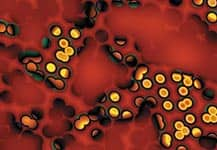Life Extension Magazine®
A study published in the Journal of the American Medical Association reveals that mainstream medical doctors remain shockingly uninformed about proper vitamin supplementation. The study sought to determine whether “high-dose” or “low-dose” vitamins could prevent a second stroke in those who had already suffered one. A total of 3,680 adults participated at 56 university-affiliated hospitals, community hospitals, private practices, and Veterans medical centers. The objective was to test two different combinations of vitamin supplements to see what effect they had on homocysteine levels and recurrent strokes.1 This federally funded study was meticulously conducted in a tightly controlled, double-blind fashion, using the most modern diagnostic equipment. Blood samples were assayed twice to ensure accuracy, and every possible step was taken to guard against statistical aberrations. There was, however, a fatal flaw with this costly study. The doses of vitamins were too low to reduce homocysteine levels to the safe ranges that were long ago established by the Life Extension Foundation. Lowest-Potency Supplement in History?In this study, half of the participants were assigned to the “low-dose” group and given a daily supplement consisting of:
The dose of vitamin B12 was so low that some of the participants had to be given extra B12 because they had become deficient in it (based on low blood values and clinical symptoms). We are not aware of any vitamin supplement that contains the tiny potencies of folic acid and vitamin B6 used in the “low-dose” arm of the study. We at Life Extension have no idea why these doctors would place half the study participants on this ridiculously small amount of daily vitamins. There are no data to substantiate that these minuscule potencies would have any value whatsoever. The other half of the study group received the so-called “high-dose” vitamin supplement consisting of:
Life Extension long ago published findings from its own research indicating that people usually need 100-1000 mg of vitamin B6 to lower homocysteine to safe ranges. We also discovered and published that folic acid lowers homocysteine to some degree, but not enough by itself to get most people into the safe range.2
How Much Homocysteine Reduction?Conventional doctors used to think that blood homocysteine levels ranging from 5 to 15 umol/L were normal. A large body of published research, however, now proves that homocysteine should be kept as low as possible.3-11 Homocysteine levels over 20 can increase coronary risk by a frightening 9.9-fold, while coronary risk is doubled in those with homocysteine above 10.2.12 Significant increases in heart attack occur in response to increased homocysteine levels.13 In people with homocysteine levels above 11, the stroke incidence was 3.89-times higher compared to those with homocysteine below 7.21 In the study comparing “low-dose” to “high-dose” vitamins, the baseline average homocysteine reading was 13.4. The “low-dose” vitamin group experienced very little change in homocysteine levels after two years. The “high-dose” arm declined from the baseline of 13.4 to 11.0. This decline was not enough to bring these so-called “high-dose” subjects into the safe homocysteine range of below 7-8.1 How Many Strokes?After two years, the researchers found that the same number of people suffered recurrent strokes in both the “low-dose” and “high-dose” vitamin groups. The study was then discontinued for ethical reasons, even though there were slightly fewer deaths in the “high-dose” group. The study authors offered several explanations for why their study failed to show results, including: enrolling people whose homocysteine levels were too low to show a large effect; using too low a dose of vitamin B12; and the study’s onset coinciding with folic acid fortification of the US grain supply, which had the effect of providing all study participants with extra folate. A special editorial published in this same issue of the Journal of the American Medical Association stated: “The study demonstrates that lowering total homocysteine from 13.4 to 11.0 umol/L does not reduce stroke recurrence.”18
Waste of Tax DollarsLong before this study was published in the Journal of the American Medical Association, the Life Extension Foundation evaluated the blood test results of hundreds of its members. We found that the amounts of vitamin B6, folic acid, vitamin B12, and TMG (trimethylglycine) needed to reduce homocysteine to safe ranges varied considerably. We reported on members who had taken as much as 15,000 mcg of folic acid a day and still had dangerously high homocysteine levels over 20. Only after supplementation with high-dose vitamin B6 (of up to 1000 mg daily) and/or TMG (of up to 8000 mg daily) were these members able to reduce their homocysteine levels to a safe range.19 Instead of wasting federal tax dollars on this fatally flawed study, one phone call to a Life Extension health advisor could have alerted these doctors to the fact that a lot more vitamin B6 would be required to adequately reduce homocysteine levels. The Life Extension health advisor would have also stated that individual dosing would be required to get all study participants down to a safe range of under 7-8 umol/L. Life Extension was the first to discover that effective homocysteine reduction is not a “one-size-fits-all” proposition. Ignoring Other Stroke Risk FactorsThe three blood markers that are most likely to predict risk of future stroke are:
Making a feeble attempt to lower only homocysteine, as was done in this study, offers little chance to reduce the incidence of stroke. To protect against stroke, it is critical that C-reactive protein, fibrinogen, and homocysteine be reduced to safe ranges. This study failed to lower homocysteine to a safe range, let alone address the other two prominent blood risk factors (C-reactive protein and fibrinogen). It is therefore no surprise that supplementation with so-called “high-dose” vitamins did not reduce the incidence of secondary stroke.
Real Victims of This Failed StudyThe people who unwittingly volunteered to participate in this study of “low-dose” and “high-dose” vitamins had already suffered a non-disabling stroke. They were allowed to take aspirin, but they could not take additional vitamin B6, folic acid, or any other vitamin supplements. While the participants were given “the best available medical and surgical management,” they were consigned to receive a daily supplement that contained virtually no vitamins, or a so-called “high-dose” supplement that failed to provide enough vitamin B6 to lower homocysteine to safer ranges. Perhaps these volunteers thought the “free vitamins” they received for participating in the study were a good deal. Regrettably, those who suffered secondary strokes may have given up their lives to participate in a study that appears to lack an ethical medical basis. Why Doctors Fear High-Dose B6Back in the early 1980s, we at Life Extension came under fierce criticism for recommending high-dose vitamin B6 supplements. The reason was that some gynecologists erroneously recommended huge doses of vitamin B6 (up to 4000 mg daily) to women for use as a diuretic. Some women developed reversible peripheral neuropathy, and the media jumped to the conclusion that vitamin B6 was harmful. We argued that some people need higher-dose B6 for protection against cardiovascular disease, and that moderate-dose vitamin B6 is not harmful as long as people also take other B vitamins and magnesium. While there have been isolated reports of peripheral neuropathy developing in people taking as little as 300-500 mg of vitamin B6 daily, I personally have taken 500-1000 mg of vitamin B6 a day for many years, as this is the dose I need to keep my homocysteine levels in check. Regrettably, the concern about isolated peripheral neuropathy led mainstream doctors to consider 25 mg of vitamin B6 a day to be a “high dose.” The facts are that this mediocre dose is insufficient to lower homocysteine to safe levels in most people. | ||||||||||||||
How to Reduce Your Stroke RiskFor the past 25 years, the Life Extension Foundation has discovered novel ways to reduce disease risk that are years ahead of conventional medicine. Back in 1981, we first recommended that members reduce homocysteine levels by taking folic acid, vitamin B12, and vitamin B6.20 In 1999, we published findings indicating that a lot more than high-dose folic acid is needed to reduce homocysteine levels to safe ranges.19 Mainstream doctors did not learn about this finding until it appeared in the Journal of the American Medical Association five years later.1 Even then, no recommendation was made to use higher-dose vitamin B6. Since so many aging people are vulnerable to stroke, we have sought to ascertain every single risk factor that is involved in the development of this horrific disease. We long ago identified components of the blood that, when elevated, dramatically increase one’s odds of having a stroke. Most Life Extension members have their blood tested once a year to ensure that they are suppressing these dangerous blood components that increase the risk of stroke and heart attack. In this month’s issue, we feature a comprehensive article on stroke prevention. Please be advised that the medical establishment does not agree with much of what we recommend, even though our methods of preventing stroke are based on studies published in the establishment’s own scientific journals.
Doctors Prove Their IgnoranceWould you trust doctors to dictate what dose of vitamins you take? A stark example of why most doctors are incapable of properly prescribing supplements can be seen in the inept stroke prevention study I just described. The vitamin potencies were too low; the patients were not given individualized doses to optimally reduce homocysteine; and the intervention was too narrow (fibrinogen and C-reactive protein levels were ignored). These stroke victims did not stand a chance in the hands of these vitamin-prescribing doctors. Those opposed to natural medicine believe that the public is too stupid to know what dose of supplements it should be taking. Yet as demonstrated in this study, most medical doctors remain completely in the dark about nutrition. There are efforts by those in the establishment to restrict consumers’ access to high-potency dietary supplements. Please be assured that the Life Extension Foundation continues to protect individual health freedom rights against an unholy alliance of drug companies, regulatory agencies, and parts of academia that are determined to maintain the status quo. As a Life Extension member, you are part of a medical renaissance that is determined to overcome the resistance of those whose economic interests lie in perpetuating the ignorance of the past. For longer life, William Faloon
| |||||||
| References | |||||||
| 1. Toole JF, Malinow MR, Chambless LE, et al. Lowering homocysteine in patients with ischemic stroke to prevent recurrent stroke, myocardial infarction, and death, the Vitamin Intervention for Stroke Prevention (VISP) Randomized Controlled Trial. JAMA. 2004 Feb 4;291(5):565-75. 2. Available at: http://www.lifeextension.com/magazine/mag2003/nov2003_awsi_02.html. Accessed January 25, 2005. 3. Perry IJ, Refsum H, Morris RW, et al. Prospective study of serum total homocysteine concentration and risk of stroke in middle-aged British men. Lancet. 1995 Nov 25;346(8987):1395-8. 4. Langman LJ, Ray JG, Evrovski J, Yeo E, Cole DE. Hyperhomocyst(e)inemia and the increased risk of venous thromboembolism: more evidence from a case-control study. Arch Intern Med. 2000 Apr 10;160(7):961-4. 5. Tanne D, Haim M, Goldbourt U, et al. Prospective study of serum homocysteine and risk of ischemic stroke among patients with preexisting coronary heart disease. Stroke. 2003 Mar;34(3):632-6. 6. Eikelboom JW, Lonn E, Genest J Jr, Hankey GJ, Yusuf S. Homocysteine and cardiovascular disease: a critical review of the epidemiologic evidence. Ann Intern Med. 1999 Sep 7;131(5):363–75. 7. D’Angelo A, Selhub J. Homocysteine and thrombotic disease. Blood. 1997 Jul 1;90(1):1-11. 8. Welch GN, Loscalzo J. Homocysteine and atherothrombosis. N Engl J Med. 1998 Apr 9;338(15):1042-50. 9. Bostom AG, Rosenberg IH, Silbershatz H, et al. Nonfasting plasma total homocysteine levels and stroke incidence in elderly persons: the Framingham Study. Ann Intern Med. 1999 Sep 7;131(5):352-5. 10. Chasan-Taber L, Selhub J, Rosenberg IH, et al. A prospective study of folate and vitamin B6 and risk of myocardial infarction in US physicians. J Am Coll Nutr. 1996 Apr;15(2):136-43. 11. Acevedo M, Pearce GL, Kottke-Marchant K, Sprecher DL. Elevated fibrinogen and homocysteine levels enhance the risk of mortality in patients from a high-risk preventive cardiology clinic. Arterioscler Thromb Vasc Biol. 2002 Jun 1;22(6):1042-5. 12. Spence JD. Patients with atherosclerotic vascular disease: how low should plasma homocysteine levels go? Am J Cardiovasc Drugs. 2001 1(2):85-9. 13. Robinson K, Mayer EL, Miller DP, et al. Hyperhomocysteinemia and low pyridoxal phosphate; common and independent reversible risk factors for coronary artery dis- ease. Circulation. 1995 Nov 15;92(10):2825- 30. 14. Available at: http://www.cdc.gov/cvh/library/fs_stroke.htm. Accessed January 25, 2005. 15. Bonow RO, Smaha LA., Smith SC, Jr,. Mensah GA, Lenfant, Claude. World Heart Day 2002: the international burden of cardiovascular disease: responding to the emerging global epidemic. Circulation. 2002 Sep 24;106(13):1602-5. 16. Available at: http://www.americanheart.org/presenter.jhtml?identifier=9217. Accessed January25, 2005. 17. Available at: http://www.americanheart.org/presenter.jhtml?identifier=4716. Accessed January 25, 2005. 18. Hanley DF. The challenge of stroke prevention. JAMA. 2004 Feb 4;291(5):621-2. 19. Available at: http://www.lifeextension.com/magazine/mag99/mar99-report2.html. Accessed January 25, 2005. 20. “Anti-Aging News” 1981 Nov;85-86 21. Iso H, Moriyama Y, Sato S, et al. Serum total homocysteine concentrations and risk of stroke and its subtypes in Japanese. Circulation. 2004 Jun 8;109(22):2766-72. |





